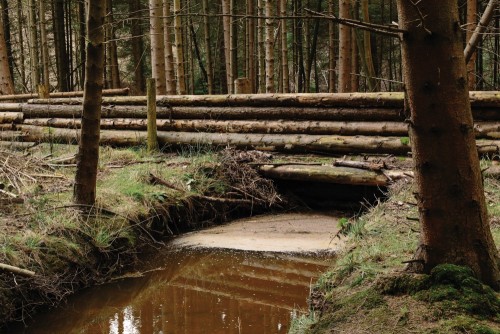Damned if we don’t
Ryan Fletcher visits Pickering where flood defences built with local knowledge and natural resources kept a community safe in the recent deluges
Mike Potter is picking his way through hillside woodland to the largest of the 167 leaky dams in the becks above his town.
“We’re not protected from every flood. Really big ones are still going to do damage – but these protected us after 24 hours of constant rain and they could have taken more,” he says.
Potter is chairman of Pickering and District Civic Society. The town, which is close to the North Yorkshire Moors, did not flood in December – while nearby York was submerged.
Although rainfall wasn’t as high on the moors as it was in areas where major flooding occurred, local people say the weather was still severe enough for Pickering to flood – as it did four times between 1999 and 2007.
The town’s leaky dams are pioneering – and apparently effective – natural measures taken to prevent a repeat of these incidents.
December 2015 was the wettest month ever recorded in Britain. Together, Storms Desmond and Eva flooded 16,000 homes – most of them in northern England. Leeds, Manchester, York, Carlisle and towns and villages across Yorkshire, Lancashire and Cumbria were all hit. The devastation was widespread and unprecedented, with costs estimated to reach at least £5 billion.
Flooding is one of the biggest natural dangers this country faces and it’s getting worse. Two million homes in Britain are at risk, with the number set to rise as global warming increases and the population grows. It is predicted that by 2050 the UK will be the most populous country in Europe, with more than 75 million people – many destined to need housing in flood-prone areas.
According to environment secretary, Elizabeth Truss, flood defences protected more than 20,000 homes in December. However, as the litany of failed and ineffective defences across the north demonstrates, building larger and higher barriers to protect communities cannot be the only solution. There is a growing realisation that defences need to be combined with moves to accommodate more water within landscapes, urban areas and even our homes.
Pickering’s leaky dams are made of logs and branches and are designed to hold up high flows of water but let regular ones through. Potter points to the high water mark on the underbrush behind the dam, where a recent flow had pooled, to illustrate the point. Complementing the dams are 187 bales of heather – which provide the same function for smaller water flows – and 29 hectares of freshly planted trees that enable rainwater to penetrate the ground more quickly. Finally there is a man-made bund, which can store up to 120,000 cubic metres of floodwater and release it gradually through a culvert.
The measures were taken after townsfolk balked at an Environment Agency proposal to build a £20 million concrete wall in the town centre. After being told that plan was being cancelled anyway – because the results wouldn’t warrant the expense – they got together with academics from Oxford, Durham and Newcastle universities to examine their options.
“If we’re going to manage water in the landscape we’ll need to plant a lot more trees.”
The result was a £2 million project that used mostly natural resources and combined local knowledge with technical expertise.
Potter explains: “Even the best sea captains use a pilot when they go down an estuary or come into a port. They might be experts in navigation, but they aren’t likely to know local details about shifting sandbanks or the way a current changes when it meets submerged rocks.
“That’s why it’s critical to work with local people on schemes like this – they know how the water behaves and where it comes out. Local people, as we’ve proved in Pickering, are also the ones who can fight for their implementation.”
Similar schemes have been successful in Doncaster, Glasgow and the villages of Bossington and Allerford in Somerset.
While such eco-friendly initiatives generally benefit smaller communities the most, and – like dredging – have to be carefully considered so as to not create worse effects downstream, Dr Nicholas Odoni, from the University of Durham, believes natural flooding remedies should be a main component of national policy. The geologist has called for millions of trees to be planted across the north of England, as part of the long-term strategy to protect against flooding.
He says: “If we’re going to manage water in the landscape one of the necessities will be to plant an awful lot more trees. A tree is capable of sucking up between 90 and 450 litres of water a day. They rock in the wind and create crevices in the soil and the accumulation of leaf litter means the top soil is not so heavily compacted. All these things mean water won’t run off so quickly when you have heavy rainfall.

“England is quite denuded of trees compared with much of the continent. During the Second World War the intention was to turn everything into productive farmland. Many woodlands were lost during that period and the policy continued into the fifties and sixties. Some would say that it has been made a lot worse by the [European Union’s] Common Agricultural Policy, because it doesn’t really pay farmers to have large areas of unproductive woodland.”
Director of the Freshwater Habitats Trust, Dr Jeremy Biggs, agrees that more can be done on heavily compacted farmland to prevent run-off, such as encouraging low lying vegetation to grow under high crops. He has also been looking at the use of trees in mitigating flood risk and, while acknowledging that they are beneficial, believes that measures to temporarily store billions of litres on floodplains could be more effective during very heavy downpours.
The trust has modelled the idea in its water-friendly farming test areas in Leicestershire, where fresh water ponds were added to the landscape. Again, the reasoning begins with the knowledge that once-common environmental features have been progressively destroyed.
Biggs says the organisation is committed to creating a million ponds across the UK, in a bid to reverse a century of freshwater habitat loss.
“It’s basically all about storage,” he explains. “The big floodplain areas are the place to do that, because it’s where the water ends up anyway and there’s space to hold it. We can see the places where it’s plausible to store the water. There’s massive swathes of lowlands in Yorkshire and the flat bits in Cumbria.”
However, any plan to prevent flooding comes with a caveat.
Biggs warns: “There are lots of things that we can do to help mitigate the risk. But in the long term, there may be places where it’s cheaper and more effective for society to pay people to leave their buildings. People don’t talk about it much, but it is economically viable to be thinking about that as well.”
For those living in places where this is unlikely to happen, there are a range of ways to defend their homes – some more expensive than others. Modifications like laying concrete floors overlaid with tiles, installing “sacrificial” basements, using permeable paving in driveways and patios, covering walls in cement plaster and raising plug sockets, can make flooding a much less devastating event. Practical purchases such as flood barriers for door frames, air brick covers and toilet stoppers can also help bolster resilience.
In April the new government-backed Flood Re scheme will ensure households in high-risk areas can purchase affordable insurance to help cover the costs of rebuilding after a flood. This will come as a relief to households who have been flooded before, many of whom are faced with exorbitant premiums and excesses of up to £10,000. However, Flood Re only applies to properties built before 2008.
Britain’s swelling population means flood-prone areas will inevitably have to be used to accommodate people. Architects can design residential communities able to withstand flooding, but the reluctance of insurers, investors and construction companies to go
near floodplains is, to some extent, impeding progress.
In Gravesend, KCA Architects have designed Albion Quayside, a housing estate that will have the Thames Estuary on one side and a salt marsh on the other. The 650 homes have been designed so that their living spaces are on the upper levels, allowing them to cope with up to two and half metres of flooding. The estate’s Thames flood defence will be integrated into a walkway and park, rather than being a fortress-like wall. As an extra precaution roads and pavements are designed so that water will flow away from the houses into a lowered public space, where it can congregate safely. Yet developers are still not coming forward.
KCA architect Kiran Curtis says: “There are other factors as well, but it is fair to say there is a reluctance [because of the flood risk]. Developers are always going to prioritise more conventional opportunities. Innovation is needed but it will take time to get people to see the value that adds.”
In response to December’s floods and the rising threat of extreme weather, the government commissioned an in-depth review of how to tackle floods in the future.
“Our 25-year plan for the environment will look in particular at how we manage river catchment areas as a whole,” flood minister Rory Stewart tells Big Issue North.
“The benefits are not just in building greater flood resilience, they will better protect our environment by uniting communities, local groups and government to work together towards a single purpose of enhancing our natural environment and managing our landscapes on a much bigger scale.”
Adapting to the unparalleled challenges brought by increased flooding is an arduous task – but one that must be met if the devastation seen throughout the north of England in December is not to become a regular occurrence.
Photos: Mark Pinder and Darren O’Brien/Meta-4 Photos

Leave a reply
Your email address will not be published.